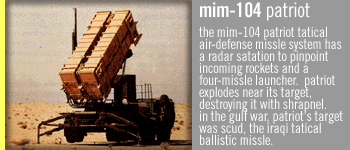



 Designed in the late 1970s as an anti-aircraft weapon, the Patriot was modified
in the mid-1980s to defend against ballistic missiles as well. The system
employs a 17.4 foot-long missile powered by a single-stage, solid-propellant
rocket motor at Mach 3 speeds. The missile weighs 2,200 pounds and has a range
of nearly 43 miles. It is armed with a 200-pound high-explosive warhead
detonated by a proximity fuse, causing shrapnel to destroy the intended
target.
Designed in the late 1970s as an anti-aircraft weapon, the Patriot was modified
in the mid-1980s to defend against ballistic missiles as well. The system
employs a 17.4 foot-long missile powered by a single-stage, solid-propellant
rocket motor at Mach 3 speeds. The missile weighs 2,200 pounds and has a range
of nearly 43 miles. It is armed with a 200-pound high-explosive warhead
detonated by a proximity fuse, causing shrapnel to destroy the intended
target.
Each Patriot system has eight M-901 storage/transportation containers that serve
as launchers, and each launcher has four missiles for a total of 32 missiles.
The launchers are attached to the M-860 trailer. The system also has the MSQ-104
engagement control station, which is mounted on an M-818 tractor. The Track Via
Missile (TVM) guidance system is the heart of the system.
--From: "Gulf War -
A Comprehensive Guide to People, Places & Weapons" by Col. Walter J. Boyne,
U.S. A.F. (RET) Signet, 1991
The Patriot system is built around a phased-array radar and fast computers. The
missile is launched and guided to the target in three phases. First, the
missile's guidance system turns the Patriot toward the target as it flies into
the radar beam. Then the computer directs the missile to the target. In the
third phase, the missile becomes semiactive as its internal radar receiver guides
it to the interception.


"Typically two missiles are fired at a target, but four would have to be fired
at a broken-up Scud to insure that at least two attacked the warhead section. The
fire unit's radars generally detected Scuds at about 70 miles, and the unit
engaged at 10-20 miles. Alerts were often provided by satellites (DSPs)
originally launched to detect Soviet missiles, and the time from alert to
engagement was typically 6-7 minutes. The time from engagement to the
destruction of the missile was typically 15-18 seconds; the Patriots and the Scud
closed at 2,000 to 4,000 ft/sec."
--From: "Desert Victory: The War for Kuwait" by Norman Friedman, Naval
Institute Press, 1991.


Throughout the Gulf War there were continuing military and news reports of the
Patriot's success in intercepting and destroying Iraqi Scuds. The Army
initially said the Patriot achieved an 80 percent success rate in Saudi Arabia and 50
percent in Israel. Those claims later were scaled back to 70 percent and 40
percent.
However, not long after the war's end, analysts began to question the
Patriot's performance. The Army and Patriot's manufacturer, Raytheon Company, vigorously
defended the system and said it was a Gulf War success story.
After a 10-month investigation in 1992 by the House Government Operations
Subcommittee on Legislation and National Security, the subcommittee concluded
there was little evidence to prove the Patriot hit more than a few Scud missiles
launched by Iraq.
Another 1992 investigation done by the General Accounting Office found that only
9 percent of the Patriot-Scud engagements "are supported by the strongest
evidence that an engagement resulted in a warhead kill." (The GAO defined
"the strongest evidence" as instances in which Scud debris or radar data
indicated that a Scud was destroyed or disabled after a Patriot detonated near it.) Except
in 9 percent of the cases, the GAO report said the Army could prove only that
"the Patriots came close to the Scuds, not that they destroyed them."
Both reports, as well as studies by analysts (in particular MIT scientists George
N. Lewis and Theodore A. Postol) concluded that Gulf War television pictures
showing Patriots chasing Scuds were misleading. The television images didn't
fully reflect that a number of the Patriots were just wounding Scuds or pushing
them off course; big chunks of both missiles then fell to the ground. In Israel,
the amount of damages and casualties increased after the Patriots were deployed
there.
FRONTLINE interview with Bernard Trainor concerning the Patriot's performance.
FRONTLINE interview with Rick Atkinson concerning the Patriot's performance.
RAYTHEON'S REBUTTAL: Raytheon Company, manufacturer of the Patriot missile system, strongly disagrees with critics of the Patriot's performance in the Gulf War. Here is their statement.
SUBCOMMITTEE REPORT: Here is the Government Operations Subcommittee's 1992 summary report which criticized the Patriot missile's performance. (The full report was never published; this summary was included in the Activities Report every committee is required to file.)
Suggested Reading: "Missile Wars" by Seymour M. Hersh, The New
Yorker, September 26, 1994.

home · oral history · war stories · weapons · maps · chronology
tapes & transcripts
FRONTLINE · wgbh · pbs online
web site copyright WGBH educational foundation
 |